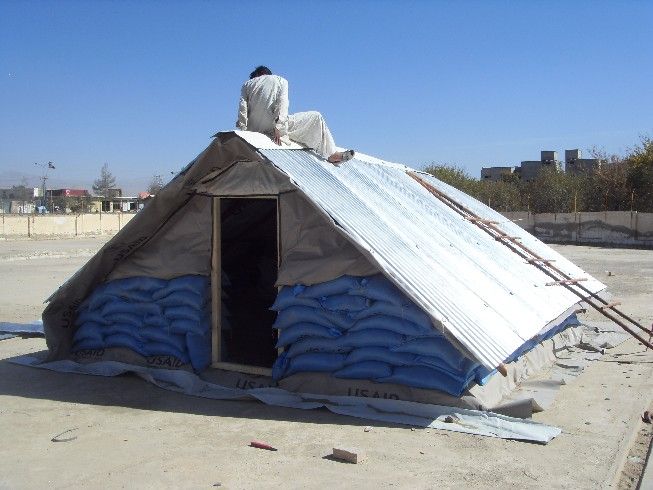
This emergency shelter was deemed a failure and rejected for use in relief efforts. Those involved with the design and evaluation of the shelter all failed to realize one simple point. Pure sand in sandbags (earthbags) will slump and shift as shown. But tamped soil consisting of an appropriate sandy soil/clay mix will compact into solid walls much like rammed earth. Also note how a running bond was not used. Full bags should overlap joints below; half bags should start alternate courses. So here’s an example of perfectly good shelter design, in my opinion, that didn’t pass grade due to lack of understanding.
The same is true of crude sandbag walls built by the military. These hastily built, temporary walls and structures are typically just bags of sand stacked on top of each other. If you add about 25% clay with sand or sandy soil, mix thoroughly and tamp the bags in level courses you will have a vastly superior wall system. This simple point makes a big difference in wall stability. That’s one reason I prefer the term earthbag building over sandbag building.

I’m in the military we tamp our bags. At least that’s what we did during my first deployment to iraq in 2005. We used rebar too ofcourse this was for a higher ups temporary dwelling in transition. So hot….. just for someone to use for like 45 mins and then everyone forgets it…..
I want to learn to make a earthbag house when i move to the philippines with my fiance for us and our son next year.
All that work for only 45 minutes use! Crazy, huh?
Yes, but the military can put one of these together in a few minutes. The army is expert sandbaggers. I’ve been trying to talk my husband into building a cob house. He wouldn’t budge. Then I begin talking about earthbags and I explained how they are made. He said “sandbags”? I can build the H*** out of sandbags! He is now warming up to building an earthbag house to live in. This is definately the alternative house to build for military or former military members!
That’s funny. Thanks for writing.
This emergency shelter does appear to be very sloppily built to me, without much care in bag placement, as Owen points out. On the other hand the end-walls of this structure are still vertical and have not caved away from being upright. If you compare this to the image at the top of this page of the circular structure being built, there is quite a difference in the care of bag placement (and compaction). The bags in that upper image were also filled with nothing but sand, dug right on-site. Of course, the fact that the structure is circular helps with its stability.